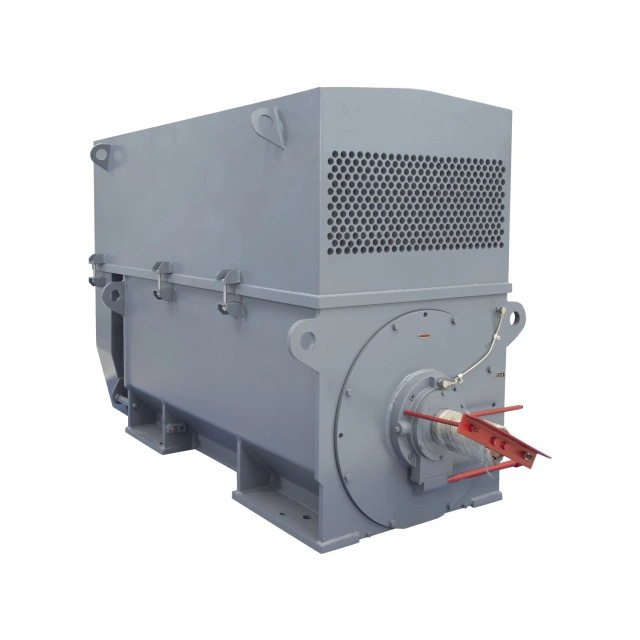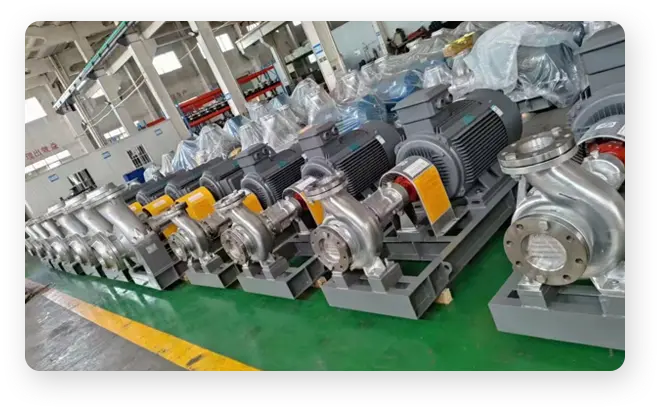Product Ranges
TEFC Squirrel Cage Low & Middle High Voltage Motor
TEFC (Y Series) Closed squirrel cage rotor three-phase asynchronous high voltage ac motor, the protection level of this series of motors is IP23, the cooling method is IC01, the insulation level is F, and the highest voltage is 11 KV.
TEFC (Y Series) large horizontal three-phase asynchronous high-voltage motors are widely used in machinery without special requirements, such as food machinery, agricultural machinery, air compressors, ventilators, industrial water pumps, cutting machine tools, transportation machinery and other general equipment. They are used as prime movers in various industrial and mining enterprises such as mines, petrochemical industries, power plants, etc. to drive blowers, coal mills, rolling mills, winches, crushers, belt conveyors and other mechanical equipment with large rotational inertia.
Frame Size
H315-1000
Output
160 -10000 KW
Frequency
50 OR 60 Hz
Voltage
11000 V
Pole
2/4/6/8/10/12
Enclosure
IP23
Cooling
IC01
Mounting
foot-IMB3/IM1001




- Closed cage rotor three-phase asynchronous motor.
- Box-type structure, light weight and good rigidity.
- The loss is reduced by 20% based on the IEC34-1 standard
- Low loss silicon steel sheet
- Vacuum Pressure Impregnation (VPI) Class F Solvent-free Paint Treatment
- End cover type spherical sliding bearing strong load capacity
- Reliable anti-corona measures
- Strong moisture resistance
- Long lifespan
- The rotor copper bars are processed by the in-slot fastening process
- When the rotor adopts copper cage rotor, the bars and end rings are welded by medium frequency welding.
This product is available in several variations. Contact us to discuss your exact requirements.
Customize Your Motors
We can customize the motor for you according to your working conditions.
- Corona protection at altitudes of 1000 meters and above
- IP55 Protection
- SKF bearings
- Double shaft
- W outdoor, F indoor anti-corrosion, WF outdoor anti-corrosion
- YTM
- Frame size is above H630
- Frame Size: H500 with thrust sliding bearing
- The motor with Current Transformer
- The motor with electric heater
Notice for Ordering
Basic conditions for normal operation of large horizontal three-phase asynchronous high-voltage motors:
- Altitude not exceeding 1000m
- The motor is rated for continuous duty S1
- The maximum ambient air temperature shall not exceed 40°C; the minimum ambient air temperature shall be -15°C for motors with rolling bearings and 5°C for motors with sliding bearings;
- The power frequency is 50Hz±l%
- The operating voltage variation range is not greater than the rated voltage ±5%
Applications
The Industrial Fan
A industrial fan is a machine that relies on input mechanical energy to increase gas pressure and discharge gas. It is a driven fluid machine.

The Water Pumps
A water pump is a machine that transports liquids or pressurizes liquids. It is mainly used to transport liquids including water, oil, acid and alkali liquids, emulsions, suspensions and liquid metals.

The Mining Machines
Mining machinery is the machinery directly used for mineral mining and mineral separation, including mining machinery and mineral separation machinery.

The Paper making Machinery
Paper making machinery refers to machinery that includes raw material preparation, pulping, paper making, and making finished rolls or flat sheets, as well as processing paper and paperboard.

The Chemical Machinery
Chemical machinery can be roughly divided into: grinding series (sand mill, colloid mill, ball mill, three-roller grinder, etc.); complete sets of coating equipment; kneading series; stirring and dispersing series; reaction series; emulsifying series; mixing series; dry powder mortar equipment; filtration series, etc.

Advantages
High Power Efficiency
Fast Delivery
Wide range of applications
Complete range of motors
Key Points You Need To Know About the High Voltage AC Induction Motor
Table of Content
CHAPTER ONE
About TEFC squirrel cage low & middle high voltage motor

The TEFC (Y series) large horizontal three-phase asynchronous high-voltage motor is a cage rotor high-voltage asynchronous motor.
It is a new product that can be used to replace the old three-phase asynchronous motor, while the YR series high-voltage horizontal winding rotor three-phase asynchronous motor series is a new product that can be used to replace the former series three-phase asynchronous motor.
The protection level of the TEFC motors is IP23, and the cooling method is IC01.
On this basis, motors with various protection levels and cooling methods can be derived, such as air-water cooling, climate protection, air-air cooling, and other series motors.
CHAPTER TWO
How to Choose High Voltage AC Induction Motor?

LUPMOTORS‘ HV Induction AC motors are widely used in industry and daily life, which has led to the birth of many equipment traders, so they need to purchase motors from factories or agents.
If you are an experienced purchaser, it is very simple to choose and purchase a motor correctly, but if you are a novice with insufficient industry experience, it may be difficult to choose the right product.
Because they may not know what characteristics the customer wants, and what information to ask the customer. In order to solve the problem of “novice” in motor procurement, LUPMOTORS has compiled the following ten points, hoping to help you.
1. Power and horsepower
Each motor has its operating power. You must understand how much power the customer wants, such as 0.75kw, 7.5kw, etc. Some customers are used to explaining with horsepower, and horsepower is represented by the letter HP. Such as 1 HP, 2HP, etc. Power and horsepower can be converted to each other, the formula is: 1HP≈0.75kw.
2. Voltage and frequency
The rated frequency of the motor is generally 50HZ, and the rated voltage is generally 220V or 380V. Of course, if it is a variable frequency motor, the frequency will be different.
3. Number of poles, speed (taking 50HZ as an example)
What is the number of poles? I will not explain it in detail. You only need to know that the number of poles is represented by the letter P on the motor nameplate, such as 2P, 4P, 6P, etc.; speed: As the name suggests, it is the number of revolutions per minute of the motor, and the unit of speed is: r/min. Similarly, there is a conversion formula for the number of poles and speed, which is: speed = 120*frequency/number of poles, such as: 2P≈3000r/min; 4P≈1500r/min; 6P≈1000r/min; 8P≈750r/min.
4. Installation method
There are many ways to install the motor. Simply put, it is divided into vertical and horizontal types, also called flange installation and foot installation. Among them, the most common and commonly used ones are:
IMB3: Horizontal foot installation
IMB5: Horizontal flange installation
IMB35: Horizontal foot installation with flange
IMV1: Vertical flange installation, with the shaft end facing downward
(Tip: The installation method is very important. If the installation method is incorrect, the motor cannot be used)
V. Insulation level and temperature rise requirements:
You only need to know the insulation level and temperature rise of the motor you want to purchase, such as F insulation/B temperature rise, etc.
VI. Protection method (protection level)
Currently, the protection level of motors used under general conditions is mostly IP54 or IP55. For special environments such as on the deck of a ship or underwater, the liquid protection level needs to be higher, such as IP56 and IP57.
VII. Altitude and environmental requirements
Altitude will also affect the working conditions of the motor. When working in plateau areas, the power and speed may not reach the rated value. At the same time, you also need to know the use environment, such as indoor, outdoor, ambient temperature, whether explosion-proof and anti-corrosion are required, etc. These factors also affect the choice of motor.
8. Starting method
The starting methods of the motor are divided into: direct starting, star-delta starting, soft starting, inverter starting, and buffer starting.
9. Use coefficient
Generally, motors are continuous working. The selected coefficient is not the larger the better, because it is easy to cause waste. Under normal circumstances, the motor runs smoothly and the use coefficient can be greater than or equal to 1. For example, S1, SF1.15.
10. Motor noise requirements
The noise requirements for LUPMOTORS’ high voltage ac industrial motors are: 90DBA/1.5M; 85DBA/1M
CHAPTER THREE
Daily Maintenance Inspection for High Voltage AC Motors

The purpose of daily maintenance inspection of LUPMOTORS high-voltage three-phase asynchronous motors is to detect equipment anomalies as early as possible, so as to facilitate timely processing and avoid aggravation of accidents.
Maintenance personnel can find anomalies based on the action of the relay protection device and the transmitted signal, or they can judge based on their own experience.

The main methods are to see, touch, listen and smell
1. Look – appearance inspection, the following abnormal phenomena can be found only by naked eyes
(1) Whether the external fasteners of the motor are loose, whether the parts are damaged, whether there is oil stain or corrosion on the surface of the equipment.
(2) Whether the contact points and connections of the motor have discoloration, burn marks and smoke marks. These phenomena are caused by abnormal conditions such as local overheating of the motor, poor conductor contact or winding burnout.
(3) Whether the instrument indication is normal.
If the voltmeter has no indication or is abnormal, it indicates that the power supply voltage is unbalanced, the fuse is blown, the rotor three-phase resistance is unbalanced, single-phase operation, poor conductor contact, etc.
If the ammeter indication is too large, it indicates that the motor is overloaded, the bearing is faulty, the winding turns are short-circuited, etc.; the motor stops, the causes are: power failure, single-phase operation, low voltage, too small motor torque, excessive load, excessive voltage drop, bearing burnout, mechanical jamming, etc.

2. Touch – Touch the surface of the casing with your hand to find out whether the motor is overheated or vibrating.
Causes of vibration:
①Unbalanced mechanical load
②Loosening of fastening parts
③Insufficient strength of motor foundation
④Improper coupling connection
⑤Uneven air gap or mixed with debris
⑥Unbalanced voltage
⑦Single-phase operation
⑧Winding failure
⑨Bearing failure, etc.
Causes of excessive motor temperature:
①Machine overload
②Blocking of cooling air duct
③Single-phase operation
④Inter-turn short circuit
⑤Voltage is too high or too low
⑥Unbalanced three-phase voltage
⑦Poor acceleration characteristics make the starting time too long
⑧Stator and rotor rub against each other
⑨Poor contact of starter
⑩Frequent starting and braking or reverse braking
⑪Excessive inlet air temperature
⑫Mechanical jamming, etc. When estimating the temperature by touching the surface of the motor, it is subjective because everyone’s senses are different, so it should be determined by experience.
3. Listen – Use a stethoscope to hear various noises of the motor
Noises include electromagnetic noise, ventilation noise, mechanical friction noise, bearing noise, etc., so as to determine the cause of the motor failure.
The mechanical reasons for the high noise are:
① Bearing failure
② Mechanical imbalance
③ Loose fastening screws
④ The coupling connection does not meet the requirements
⑤ Stator and rotor cores rub against each other, etc.;
The electrical reasons are:
① Voltage imbalance
② Single-phase operation
③ Winding has short circuit or breakdown failure
④ Poor starting performance
⑤ Poor acceleration performance, etc.
4. Smell – Burning and odor can be found by smell
The causes of this phenomenon are:
① Motor overheating
② Winding burnout
③ Single-phase operation
④ Winding failure
⑤ Bearing failure, etc.
Routine maintenance inspections of motors can be divided into daily inspections, monthly or regular inspections, and annual inspections.
Learn More From FAQs
You’ll find yourself working in a true partnership, resulting in an incredible experience and a competitive end products.
We are a professional manufacturer that produces and sells a variety of motors.
No. We can accept an order just for 1 motor.
For all our customers, they may have different technical requirements, such as power, voltage, type, etc. The price also varies according to different order quantities. Therefore, it is really difficult for us to provide a price list. If you can share your detailed specifications and order quantity, we will provide the price to you.
We can provide both FOB and CIF prices.
Contact Us
Consult your motor expert
LUPMOTORS is your best choice!



